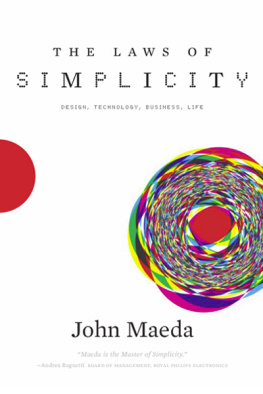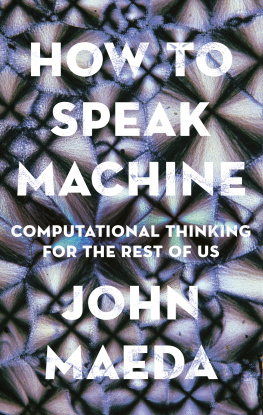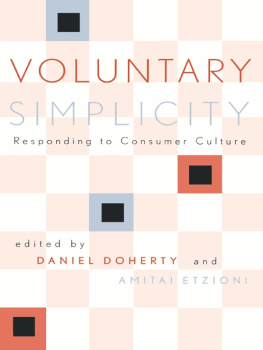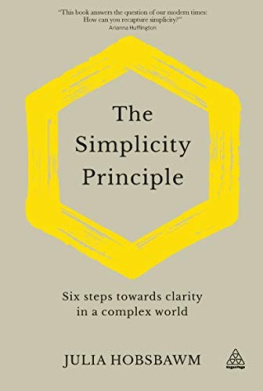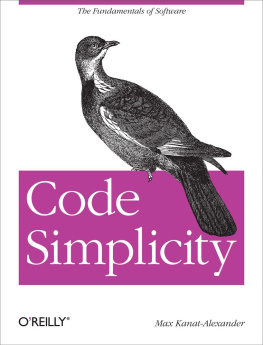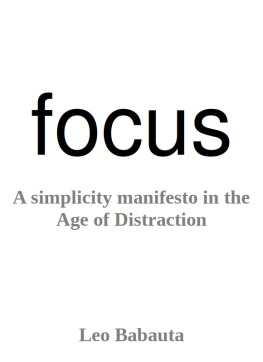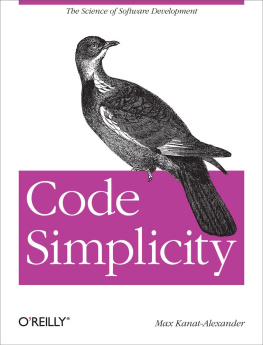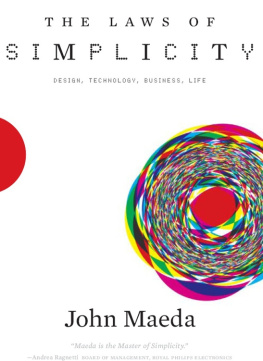
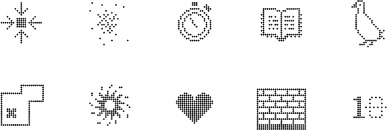
THE LAWS OF
SIMPLICITY
John Maeda
DESIGN, TECHNOLOGY, BUSINESS, LIFE
The MIT Press
Cambridge, Massachusetts
London, England
2006 Massachusetts Institute of Technology
All rights reserved. No part of this book may be reproduced in any form by any electronic or mechanical means (including photocopying, recording, or information storage and retrieval) without permission in writing from the publisher.
MIT Press books may be purchased at special quantity discounts for business or sales promotional use. For information, please email or write to Special Sales Department, The MIT Press, 55 Hayward Street, Cambridge, MA 02142.
This book was set in Mercury Text and DotMatrix-Two by the author and was printed and bound in the United States of America.
Library of Congress Cataloging-in-Publication Data
Maeda, John.
The laws of simplicity/John Maeda.
p cm.(Simplicity: Design, Technology, Business, Life)
Includes index.
ISBN 0-262-13472-1ISBN 978-0-262-13472-9 (hc.: alk. paper)
1. Systems engineering. I. Title.
TA168.M255 2006 650.1dc222006044885
10 9 8 7 6 5 4 3 2 1

For Kris
I promise to love you more, and never less.
Contents
SIMPLICITY = SANITY
Law 1 REDUCE
Law 2 ORGANIZE
Law 3 TIME
Law 4 LEARN
Law 5 DIFFERENCES
Law 6 CONTEXT
Law 7 EMOTION
Law 8 TRUST
Law 9 FAILURE
Law 10 THE ONE
Key 1 AWAY
Key 2 OPEN
Key 3 POWER
LIFE
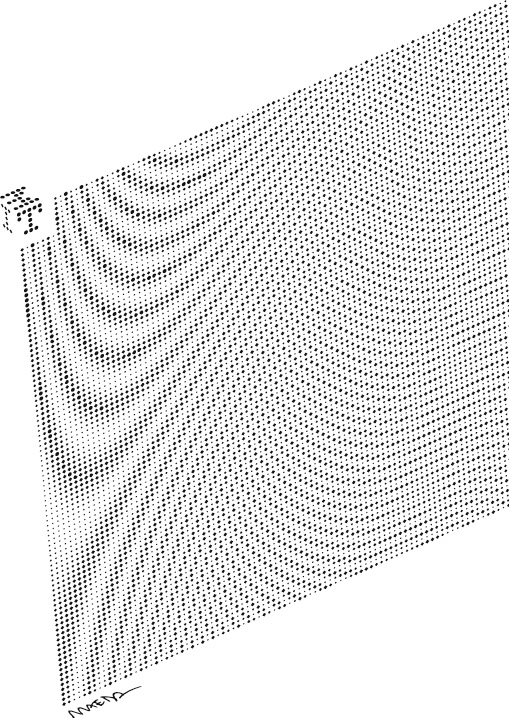
SIMPLICITY=SANITY
Technology has made our lives more full, yet at the same time weve become uncomfortably full.
I watched the process whereby my daughters gleefully got their first email accounts. It began as a tiny dropemails sent among themselves. It grew to a slow drip as their friends joined the flow of communication. Today it is a waterfall of messages, e-cards, and hyperlinks that showers upon them daily.
I urge them to resist the temptation to check their email throughout the day. As adults, I tell them, they will have ample opportunity to swim in the ocean of information. Stay away! I warn, because even as an Olympic-class technologist, I find myself barely keeping afloat. I know that Im not alone in this feeling of constantly drowningmany of us regularly engage (or dont) in hundreds of email conversations a day. But I feel somewhat responsible.
My early computer art experiments led to the dynamic graphics common on websites today. You know what Im talking aboutall that stuff flying around on the computer screen while youre trying to concentratethats me. I am partially to blame for the unrelenting stream of eye candy littering the information landscape. I am sorry, and for a long while I have wished to do something about it.
Achieving simplicity in the digital age became a personal mission, and a focus of my research at MIT. There, I straddle the fields of design, technology, and business as both educator and practitioner. Early in my ruminations I had the simple observation that the letters M, I, and Tthe letters by which my university is knownoccur in natural sequence in the word SI M PL I CI T Y. In fact, the same can be said of the word CO M PLEX IT Y Given that the T in M-I-T stands for technologywhich is the very source of much of our feeling over-whelmed todayI felt doubly responsible that someone at MIT should take a lead in correcting the situation.
In 2004, I started the MIT SIMPLICITY Consortium at the Media Lab, comprised of roughly ten corporate partners that include AARP, Lego, Toshiba, and Time. Our mission is to define the business value of simplicity in communication, healthcare, and play. Together we design and create prototype systems and technologies that point to directions where simplicity-driven products can lead to market success. By the publication date of this book, a novel networked digital photo playback product co-developed with Samsung will serve as an important commercial data point to test the validity of the Consortiums stance on simplicity.
When the blogosphere began to emerge, I responded and created a blog about my evolving thoughts on simplicity. I set out to find a set of laws of simplicity and targeted sixteen principles as my goal. Like most blogs, it has been a place where I have shared unedited thoughts that represent my personal opinions on a topic about which I am passionate. And although the theme of the blog began just along the lines of design, technology, and business I discovered that the readership resonated with the topic that underlies it all: my struggle to understand the meaning of life as a humanist technologist.
Through my ongoing journey Ive discovered how complex a topic simplicity really is, and I dont pretend to have solved the puzzle. Having recently spoken to an 85-year old MIT linguistics professor who has been working on the same problem his entire life, I am inspired to grapple with this puzzle for many more years. My blog led me to the fact that there arent sixteen laws, but rather the ten published in this volume. Like all man-made laws they do not exist in the absolute senseto break them is no sin. However you may find them useful in your own search for simplicity (and sanity) in design, technology, business, and life.
SIMPLICITY AND THE MARKETPLACE
The marketplace abounds with promises of simplicity. Citibank has a simplicity credit card, Ford has keep it simple pricing, and Lexmark vows to uncomplicate the consumer experience. Widespread calls for simplicity formed a trend that was inevitable, given the structure of the technology business around selling the same thing new and improved where often improved simply means more. Imagine a world in which software companies simplified their programs every year by shipping with 10% fewer features at 10% higher cost due to the expense of simplification. For the consumer to get less and pay more seems to contradict sound economic principles. Offer to share a cookie with a child and which half will the child want?
Yet in spite of the logic of demand, simplicity sells as espoused by New York Times columnist David Pogue in a presentation at the 2006 annual TED Conference in Monterey. The undeniable commercial success of the Apple iPoda device that does less but costs more than other digital music playersis a key supporting example of this trend. Another example is the deceivingly spare interface of the powerful Google search engine, which is so popular that googling has become short-hand for searching the Web. People not only buy, but more importantly love, designs that can make their lives simpler. For the foreseeable future, complicated technologies will continue to invade our homes and workplaces, thus simplicity is bound to be a growth industry.
Simplicity is a quality that not only evokes passionate loyalty for a product design, but also has become a key strategic tool for businesses to confront their own intrinsic complexities. Dutch conglomerate Philips leads in this area with its utter devotion to realizing sense and simplicity. In 2002 I was invited by Board of Management Member Andrea Ragnetti to join Philips Simplicity Advisory Board (SAB). I initially thought that sense and simplicity was merely a branding effort, but when I met in Amsterdam with Ragnetti and his CEO Gerard Kleisterlee at the first meeting of the SAB I saw the greater ambition. Philips plan to reorganize not only all of their product lines, but also their entire set of business practices around simplicity. When I tell this story to industry leaders the consistent feedback I get is that Philips is not alone in the quest to reduce the complexities of doing business. The hunt is on for simpler, more efficient ways to move the economy forward.
Next page
